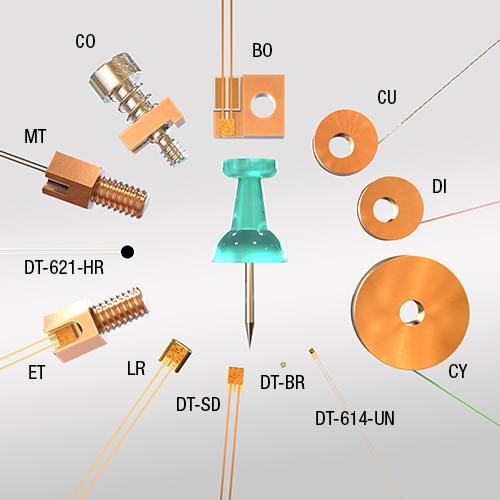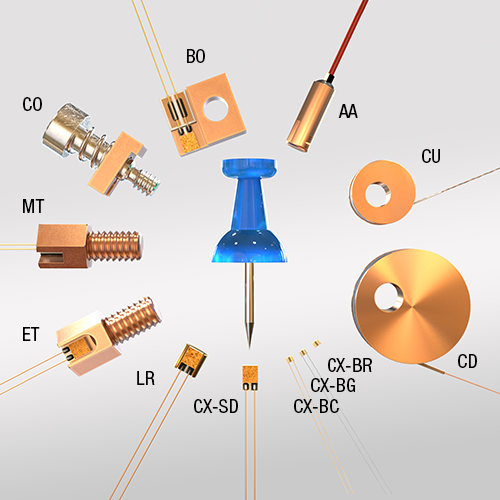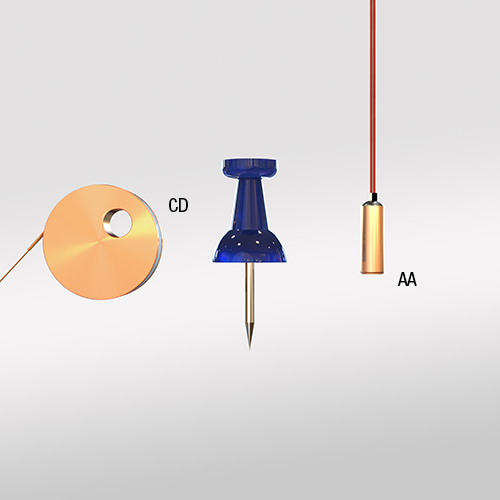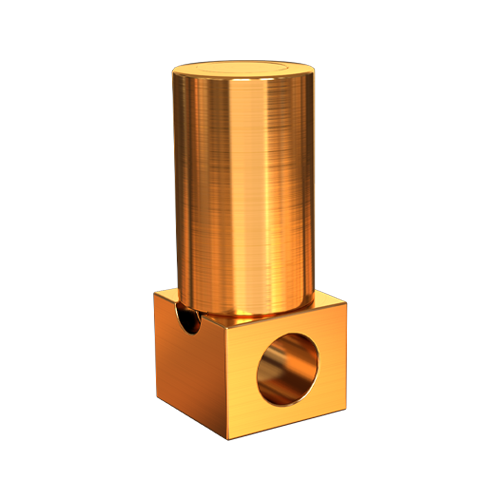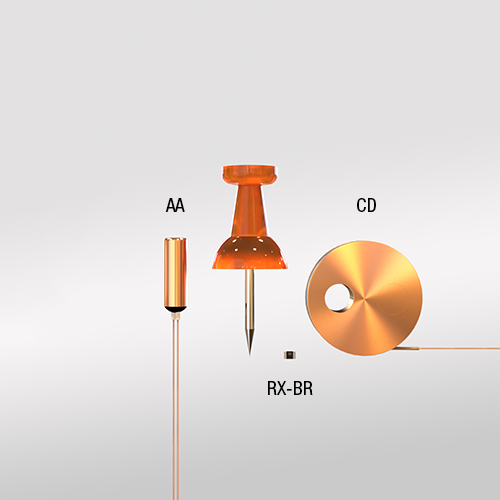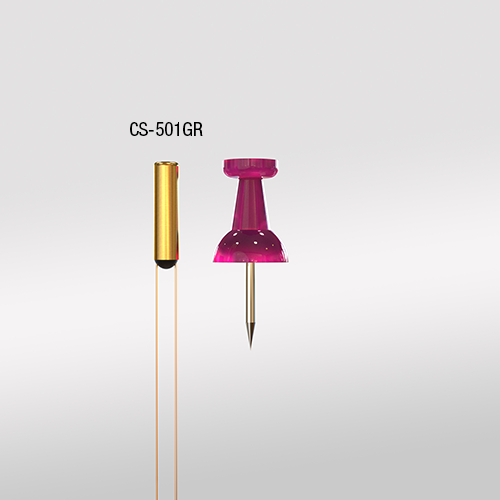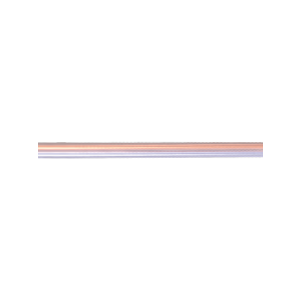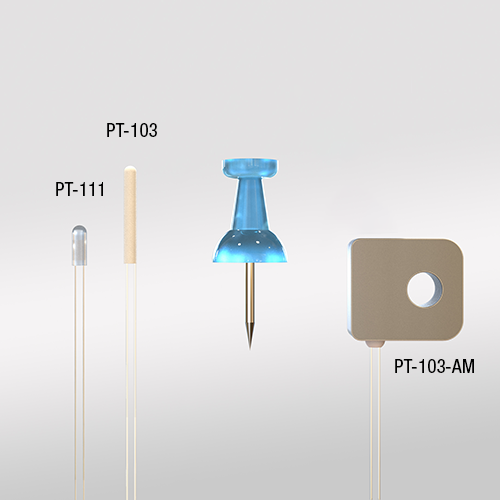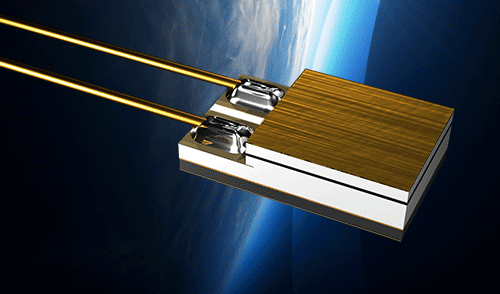Cryogenic temperature sensors

| Temperature range | Standard curve (interchangeable) | Radiation resilient | Performance in magnetic field | Vacuum compatible | Best for | |
| Negative Temperature Coefficient RTDs | ||||||
Cernox® | 0.10 K to 420 K | Best choice for cryogenics | Good to above 1 K | Ultra-high (to 10‑10 Pa) | Wide temperature range; best accuracy and precision in presence of magnetic fields or radiation; different models to maximize sensitivity at various temperatures; most popular cryogenic sensor family | |
Interchangeable Rox™ | 0.05 K to 40 K | ■ | ■ | Good | High (to 10‑4 Pa) | When sensor interchangeability is desired below 1.4 K or in the presence of moderate magnetic fields |
Ultra-low temperature Rox™ | 5 mK to 40 K | Not recommended | High (to 10‑4 Pa) | Temperature measurement below 50 mK | ||
Germanium | 0.05 K to 100 K | ■ | Not recommended | High (to 10‑4 Pa) | Highly stable measurements over long periods of time | |
| Diodes | ||||||
Silicon | 1.4 K to 500 K | ■ | Fair above 60 K | Ultra-high (to 10‑10 Pa) | Great value general-purpose sensor for cryogenic applications down to 1.4 K that don't involve magnetic fields or radiation | |
| Positive Temperature Coefficient RTDs | ||||||
Platinum | 14 K to 873 K | ■ | ■ | Fair above 30 K | High (to 10‑4 Pa) | Accurate and repeatable measurements above 500 K, up to 873 K; affordable sensor for applications where temperatures remain above 14 K |
| Other | ||||||
Capacitance | 1.4 K to 290 K | Excellent | High (to 10‑4 Pa) | Highest control stability when in the presence of massive magnetic fields at cryogenic temperatures; requires a secondary sensor to provide temperature values | ||
Thermocouple wire | 1.2 K to 1543 K | ■ | Fair | Ultra-high (to 10‑10 Pa) | Situations where the temperature exceeds 600 °C (873 K); lowest priced sensor for other temperature ranges, but at the cost of significant loss of accuracy | |
| Specialty | ||||||
HR Series | 20 K to 420 K | ■ | Excellent | Ultra-high (to 10‑10 Pa) | Space applications | |
DT-670-SD
- Best accuracy across the widest useful temperature range—1.4 K to 500 K—of any silicon diode in the industry
- Tightest tolerances for applications from 30 K to 500 K of any silicon diode to date
- Rugged, reliable Lake Shore SD package designed to withstand repeated thermal cycling and minimize sensor self-heating
- Conformance to standard Curve DT-670 temperature response curve
- Variety of packaging options
DT-670E-BR
- Temperature range: 1.4 K to 500 K
- Bare die sensors with the smallest size and fastest thermal response time of any silicon diode on the market today
- Non-magnetic sensor
DT-621-HR
- Temperature range: 1.4 K to 325 K*
- Non-magnetic package
- Exposed flat substrate for surface mounting
*Calibrated down to 1.4 K, uncalibrated (Curve DT-670) to 20 K
- Low magnetic field-induced errors
- Temperature range of 100 mK to 420 K (model dependent)
- High sensitivity at low temperatures and good sensitivity over a broad range
- Excellent resistance to ionizing radiation
- Bare die cryogenic temperature sensor with fast characteristic thermal response times: 1.5 ms at 4.2 K, 50 ms at 77 K
- Broad selection of models to meet your thermometry needs
- Excellent stability
- Non-magnetic package options available (AA, BC, BG, BR)
- Variety of packaging options
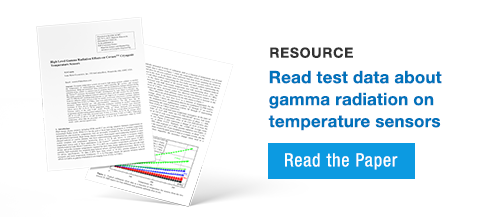
Temporarily unavailable — please consider Cernox® as an alternative
- Recognized as a “Secondary Standard Thermometer”
- High sensitivity provides sub-millikelvin control at 4.2 K and below
- Excellent reproducibility better than ±0.5 mK at 4.2 K
- Various models for use from 0.05 K to 100 K
- Excellent resistance to ionizing radiation
- Calibrations down to 5 mK
- Readings from 5 mK to 40 K
- Optical shielding reduces unwanted sensor heating
RX-102A
- Standard curve interchangeable
- Good radiation resistance
- Useful down to 50 mK
- Low magnetic field-induced errors
RX-202A
- Standard curve interchangeable
- Good radiation resistance
- Monotonic from 50 mK to 300 K
- 4× improvement in magnetic field-induced errors over other ruthenium oxides
RX-103A
- Standard curve interchangeable
- Good radiation resistance
- Best choice for interchangeability from 1.4 K to 40 K
- Low magnetic field-induced errors
- Virtually no magnetic field-induced errors
- Capable of mK control stability in the presence of strong magnetic fields
- Monotonic in C versus T to nearly room temperature
Type E (Chromel-Constantan)
Has the highest sensitivity among the standard thermocouple types typically used at low temperatures—the best choice for temperatures down to 40 K.
Type K (Chromel-Alumel)
Recommended for continuous use in inert atmospheres. Has a sensitivity of 4.1 mV/K at 20 K (about ½ of Type E).
- Temperature range: 14 K to 873 K
- Conforms to IEC 751 standards for platinum sensors
- High reproducibility: ±5 mK at 77 K
- Full material traceability for 15 years
- Resistance and sensitivity data available for all sensors
- Reduce lead time
- Gain confidence from our test protocol
- No hidden costs—pay only for the sensors you buy
What is a cryogenic temperature sensor?
Cryogenic sensors are thermometry devices specially engineered for the rigors of low-temperature environments and include versions for measurements down to 5 mK. They can also be designed to withstand wide temperature ranges and UHV applications.
What are the types of temperature sensors?
Temperature sensors come in several types, each suited for specific applications. Common types include thermocouples, which measure temperature using voltage differences between two metals; resistance temperature detectors (RTDs), such as platinum RTDs, which offer high accuracy and stability; thermistors, which provide high sensitivity over limited ranges; and semiconductor sensors like silicon diodes for cryogenic use. In cryogenic research, specialized sensors such as Cernox®, germanium, ruthenium oxide, and ULT Rox are used for precise measurements at extremely low temperatures.
What is the most reliable temperature sensor?
The most reliable temperature sensor depends on the application. For cryogenic research, Cernox® sensors are widely considered the best choice because they offer excellent accuracy, stability, and low magnetic field dependence across a wide range from 0.1 K to 420 K. Germanium sensors provide exceptional accuracy below 100 K, while platinum RTDs are highly reliable for higher temperature ranges. Each sensor type is selected based on temperature range, magnetic field resilience, and environmental conditions.
What is the purpose of a temperature sensor?
The purpose of a temperature sensor is to measure and monitor temperature accurately for process control, safety, and research. In scientific applications, temperature sensors ensure precise thermal conditions for experiments, protect sensitive equipment, and maintain stability in environments such as cryostats or vacuum chambers. They convert temperature changes into electrical signals, enabling real-time monitoring and data logging for critical research and industrial processes.


